Healthcare marketing is a new and growing field. Especially in regard to making use of digital marketing as opposed to traditional marketing. Only recently have regulations started to become clearer, and healthcare providers, insurance companies, and private practices have begun using SMM, chatbots, email marketing, and more. Let’s take a deep dive into digital marketing for the healthcare industry in 2020.
Content:
- What is healthcare marketing?
- What are the goals of healthcare marketing?
- Steps for planning your healthcare marketing strategy
- Email marketing for the healthcare industry
- Email marketing for healthcare tips
- Email healthcare marketing examples
- Chatbot marketing for the healthcare industry
- Chatbot marketing for healthcare tips
- Healthcare chatbot examples
- Social media marketing for healthcare
- SMM for healthcare tips
- Examples of SMM in healthcare
- Pulling it all together
What is healthcare marketing?
Marketing in the healthcare industry has many things in common with other forms of digital marketing but naturally has some specific nuances. There are plenty of examples of B2B healthcare marketing, but we are going to focus on the largest segment which is B2C marketing in healthcare.
The nature of healthcare requires a customer-centric approach and should focus on providing value in addition to raising brand awareness and benefitting public health along the way. Using pushy sales techniques is a sure way to sully your reputation. However, creating valuable interesting content benefits your potential customers and allows you to showcase new findings, medical approaches, and generally the quality of your services.
For example, medical infographics are extremely popular and helpful for public health and add authority to your brand.
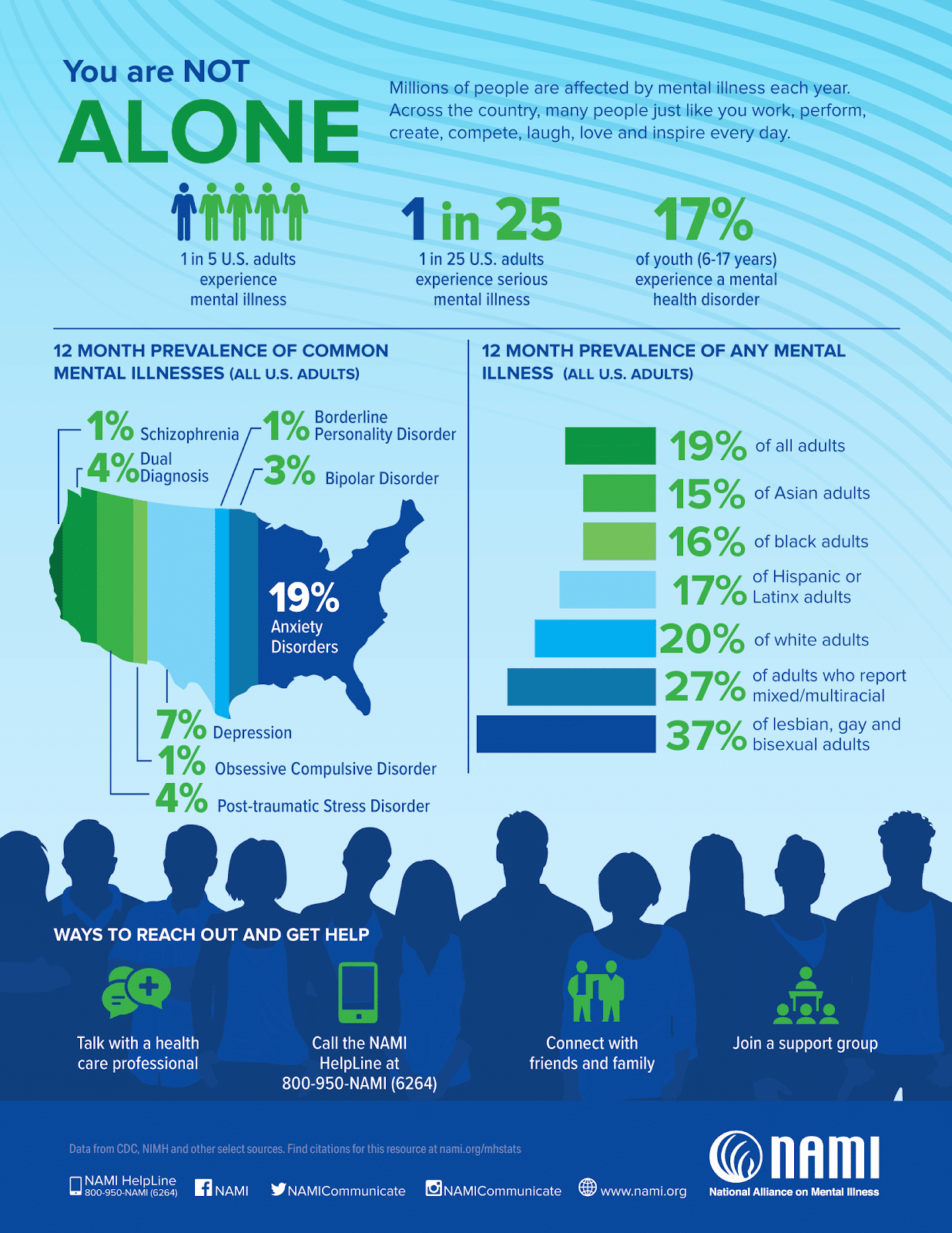
NAMI is not exactly a healthcare provider, but this is part of their marketing to raise donations and support the healthcare systems that they endorse. This truly valuable infographic is different from common approaches to digital marketing in other industries because it focuses on more than closing a deal. Primarily, it provides valuable information and gives people suffering from mental illness resources to improve their health, promoting public health as well as encouraging people to engage with the healthcare industry.
What are the goals of healthcare marketing?
Let’s take a look at some of the things that your marketing efforts can help you achieve.
- Retain customers. Retaining an existing customer is significantly cheaper than onboarding a new customer. Marketing health services will help your brand stay top of mind among your customers. Specifically, healthcare systems are able to make use of word of mouth and social proof, being on people’s minds means that they will share their brand with their friends and family.
- Reach out. There are tons of options for consumers in the healthcare world and getting your brand out there is a must. Without being visible, you are missing out on the potential for getting new leads. In 2020, it is absolutely critical to have an online, and particularly social media, presence. Working social media marketing into your overall digital marketing plan will help you reach a wider audience.
- Grow your brand. Surely, you want to attract new leads, but in the medical industry, you may also want to grow your company and attract new talented experts to enhance your team.
These goals take work to achieve but will boost your success and have a high ROI.
Steps for planning your healthcare marketing strategy
The first thing that you need to do is look at existing stories and information about your company that appear online. You can take advantage of positive reviews, respond to them, share positive news stories, etc. Critically, it is important to not sweep negative reviews or problematic stories under the rug. Respond to them, fix the issue, improve your PR. Understanding what the public doesn’t like can be just as useful as understanding what they like.
Now that you have an idea about what is already out there, you want to optimize existing content and add to it as you develop your plan. We will use your findings in the following steps as we layout your initial marketing approach. Keep in mind that this is a constantly evolving process, but with these tips, you will have a good start.
Let’s take a look at an outline of the process:
- Research. You need to know your market, your target audience, and most importantly, what they need. Who do you serve? Who can you serve? What can you do that your competition doesn’t? This isn’t the sexiest part of the process, but it is the most important and if done well will squeeze more ROI out of your marketing.
- Choose channels and prepare campaigns. Choosing the right place to interact with your subscribers is crucial to digital marketing success. Email, chatbots, social media, and content marketing are all useful in their own way. Email is a great place to start, but as your brand grows, so too should your number of channels.
- Send, analyze, and improve. Unfortunately, our best work requires edits and sometimes returning to the drawing board more than once. Fortunately, digital marketing platforms like SendPulse offer loads of statistics and reports on the success of your campaigns. Looking at the numbers and understanding what to expect, will help you get the most out of your marketing efforts.
Additionally, anyone helping with healthcare marketing needs to keep personal and medical privacy laws in mind. There is HIPPA in the US and the GDPR in the EU. These protections may limit the range of possibilities for marketing content, but you’ll be glad that you followed them.
Email marketing for the healthcare industry
Now that you have an outline for your plan, let’s look more closely at the moving parts.
First, you need to build a mailing list. The easiest way to do this is to make use of a subscription form to ask users for their email address and other demographic information to personalize and segment your email campaigns. You can place the form right on your site.
In the medical world, you will also have a lot of face to face contact with potential subscribers. This could be in the form of people visiting your doctor’s office or hospital and filling out a patient information form. When a new patient enters your health system for the first time, it is a great idea to also offer them the opportunity to opt-in to your email communications as well. Remember you need their explicit permission to send them email campaigns, so be sure to ask for permission on your paper or online form. Offer patient preferences during opt-in, some people may simply not be interested in certain kinds of emails that you are going to send.
Email marketing for healthcare tips
Here are a few tips to keep in mind for your email campaigns, to make sure that you are following email marketing best practices:
- Use double opt-in subscriptions: Make sure that your list is made up of only interested and consenting subscribers.
- Include an unsubscribe link: Give users an easy way out if they are no longer interested in receiving emails from your organization.
- Segment your mailing list: Collect demographic information to target groups of your audience who are most likely to need your services.
- Personalize your emails: Be sure to add a personal touch to your emails to increase your open rates, and give a customer-centric feel to your marketing efforts.
- Automate your emails: Create an automation flow to take care of sending confirmation emails and much more. Sending manual emails is time consuming and is easy to replace with automation flows.
For dental and vision services you can offer discounts on checkups or offer deals on specific services related to seasonal changes or around the holidays. Many people pay out of pocket for these services, give them an incentive to come to you.
Let’s see some of these tips in action with some example emails from healthcare providers.
Email healthcare marketing examples
When we leave a doctor’s appointment, we walk out the door with lots of paperwork, but you can also send a follow-up email. Be it summaries, public health information, or medication instructions, you can offer to send these in a digital form as well as a paper form. Likewise, you can use follow-up emails to ask for feedback about your customer’s experience.
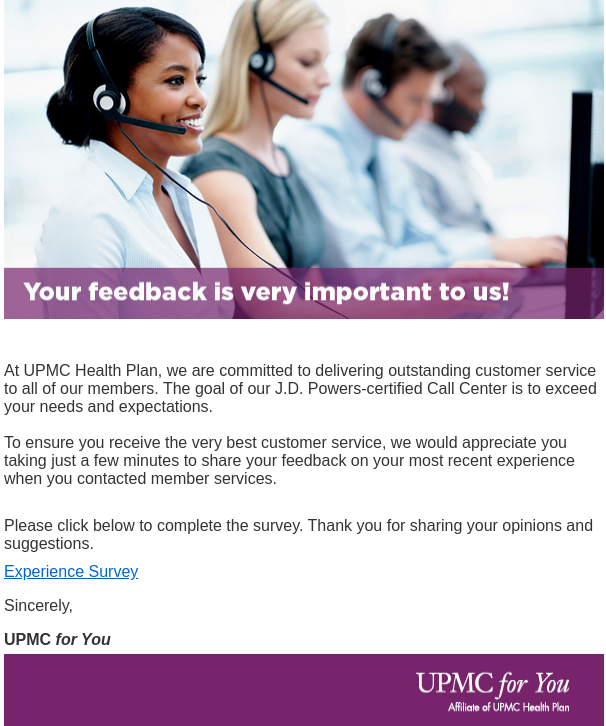
An appointment reminder is another type of email a healthcare service can send. It is similar to event confirmation emails in other spheres of marketing. Use these emails to remind patients that they have an upcoming appointment and give information about anything that a patient may need to bring with them, for example, an insurance card or medications.
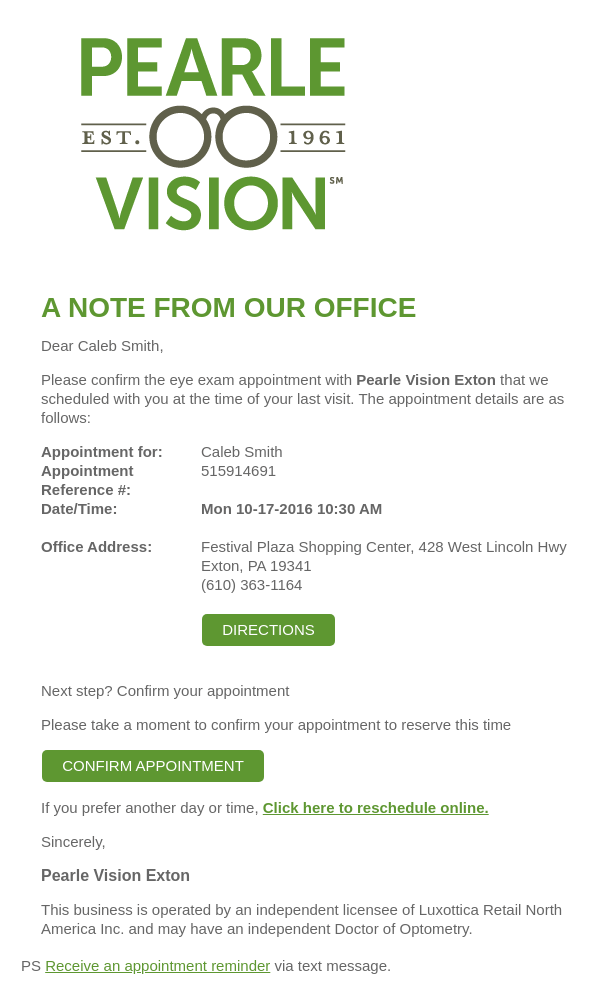
Reminder emails can also help people who often forget that it has been a while since their last check-up, appointment, or consultation with a doctor. Use these emails to promote health and drum up some business from your customers who may have forgotten that it is time for a routine visit.
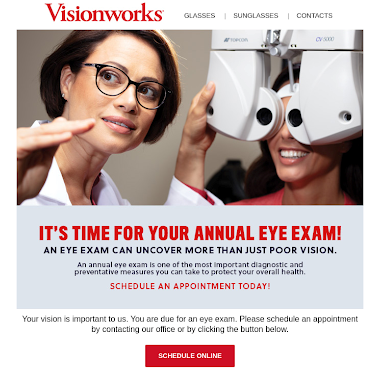
Send updates and e-newsletters, these emails are similar to other kinds of marketing newsletters, but you should put the focus on value in addition to informational content for the healthcare industry. Do you have a new specialist? Tell your customers about them, and what they can do to improve your practice. New treatment or program for your patients? Tell them about it via email. These emails promote public health and make your brand look good.
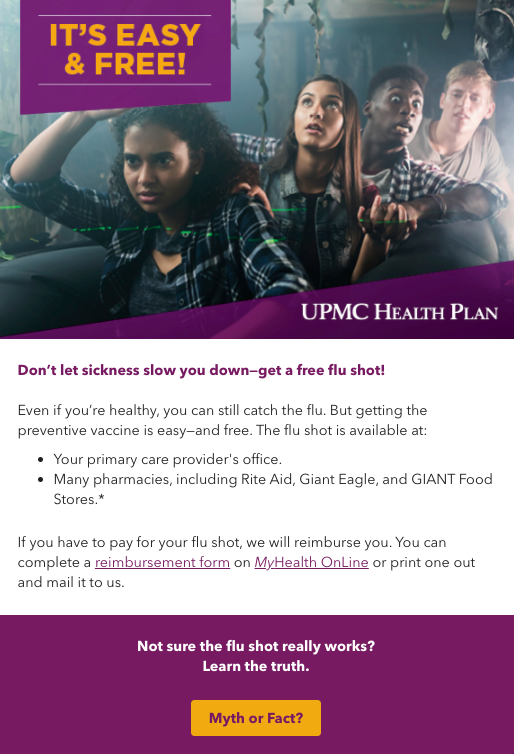
Chatbot marketing for the healthcare industry
In 2020, chatbot marketing is simply a must. The healthcare industry is well-positioned to take advantage of this medium due to there being many touchpoints and situations that require quick communication. Think of the examples from email marketing, flu season updates, feedback requests, and more. Chatbots synergize with email marketing and will help you cover all of your bases in your healthcare marketing endeavor.
With the rise of telemedicine, healthcare is becoming more and more digital. Being available on all of the digital channels that your customers are on improves your brand’s image and increases your availability.
Speaking of availability, that is the name of the game with chatbots. You no longer need someone to man your messenger profile 24/7. Let the chatbot do the work for you and save your specialists for working with patients.
Chatbot marketing for healthcare tips
It doesn’t take long to program your chatbot and you always have the option of letting customers communicate with a person if the bot cannot solve their problem. Let’s check out some tips to keep your schedule clear and your customers happy:
- Keep it short. Chatbots messages should be shorter than emails. Facebook Messenger is not close to the same medium as an email, as such, stick to the key points and be brief.
- Create a logical flow. Use a chatbot builder to create your final product, but before you get to that step it is best to create a mindmap with all of the possible situations and your answers to them. It will take some time and testing, but you will thank yourself in the future if you thoughtfully lay out the logic before your chatbot goes live.
- Call in the big guns when necessary. Unfortunately, you can have a killer plan, but some requests will be outside of the abilities of your bot. Fortunately, if you have a rock-solid plan, this will be uncommon but will come up once in a while in any case. Give your users the option to talk to a real person if the bot cannot point them in the right direction. This may be especially necessary if a patient is using your bot to ask a question about their specific medical history. But, this will save you from having someone sit by a phone all day in most situations.
- Strike a balance. Many companies like to give their chatbot some personality and make the process entertaining and informative for their subscribers. You can definitely do some of this too, but it is important to keep it professional at the same time. A clothing company can have their chatbot send memes, but your healthcare marketing chatbot should take a more professional approach.
Healthcare chatbot examples
This is an example Facebook Messenger bot that showcases everything that a chatbot can do for you. You can see that the chatbot includes useful quick replies and helps users find the treatment that they need, choose a doctor, and schedule an appointment. This is a convenient way to quickly get information right from the source, you’re probably already browsing Facebook anyway.
Pros:
- Quick reply buttons
- Useful information is displayed in a carousel
- Lots of options and robust functionality
Cons:
- No personalization or greeting
- Slow response time
This chatbot is a great resource for patients seeking to understand what their symptoms mean. The bot asks users questions about their symptoms and then sends the information off to doctors to make a diagnosis and treatment plan.
Pros:
- Personalized welcome message
- Friendly greeting and playful tone with the “So, you’re a robot” option that actually provides more information about the service and explains that the information is sent to a doctor
- Simple to use quick reply buttons that make the chat feel more conversational
Cons:
- Because the chatbot takes a conversational approach, information takes longer to get
- More complex flows which may turn some people away
This chatbot provides an absolutely critical service for people who are diagnosed with cancer or have family or friends battling the disease. This bot gives people the support that they desperately need. This bot aggregates resources for both patients and their families and friends. Knowing that there is support out there makes this journey somewhat more manageable.
Pros:
- A personalized message with a hopeful tone explaining what the bot can do
- Information for multiple groups (i.e. patients and their family and friends) arranged in a nice looking carousel
- Provides an invaluable service for people affected by cancer
Cons:
- Slightly long introduction
- Limited quick reply buttons
So now you have some inspiration about how you can use chatbots for many different aspects of marketing in healthcare. Set up a chatbot to free up resources, reach a wider audience, and much more.
Let’s dig into social media marketing for the healthcare industry.
Social media marketing for healthcare
Frankly, we could do an entire blog post on just SMM for healthcare, but we won’t do that now. With growing regulations, healthcare marketing is trending towards using social media in conjunction with email marketing and content marketing to boost outreach. Having a customer-facing social media page does a lot for PR and brand recognition on the whole.
You can use SMM to post a lot of the same content that you would also use other channels for. Got a new blog post? Share it on social media. New public health information? You guessed it, your customers can find it on their social timelines. Likewise, most social media platforms also show ratings from your organization which you can use for social proof and even work into your efforts on other channels.
SMM for healthcare tips
Social media marketing isn’t rocket science, but it does have a few special features compared to other channels. Here are a few things to keep in mind for doing SMM as a healthcare organization:
- Be personable. Using social media is the perfect way to speak to your audience in a more natural and relaxed way. Social media is for connecting with people, after all. Don’t be afraid to talk with your customers in the comments and make them feel appreciated. Now is your chance to further humanize your brand and create a community. You can highlight patients’ journeys to inspire others and show the value of your services.
- Share useful content. Here’s your chance to promote your blog posts, share updates, and most importantly video. Video content is the king of SMM, so be sure to make some high-quality video content to sprinkle in alongside your blog posts, updates, and photos. Before you post something make sure that it is adding value to your page and benefits your audience.
- Use cross-posting. As one part of your overall marketing strategy, SMM can synergize with other social platforms and even other channels that you use to market your brand. Each platform and channel should not be a carbon copy of each other, but rather work together to create a cohesive brand image. Share content in multiple places, but make sure that it makes sense for the medium, sending a single image isn’t great for email, but will work on almost every social platform.
- Be consistent. With SMM specifically, it is important to choose a tone and stick to it. For healthcare, you don’t want to be too silly, but you can loosen things up a little for your social pages. Also, find the best frequency of posts. No one likes minute-by-minute updates, but posting too infrequently will surely have your page unfollowed or forgotten.
Examples of SMM in healthcare
Here you can see UPMC has dedicated some time to designing an excellent Facebook page so that their consumers can learn about the brand, new research, and much more. This is a great example of using SMM to empower your overall marketing strategy and increase outreach.
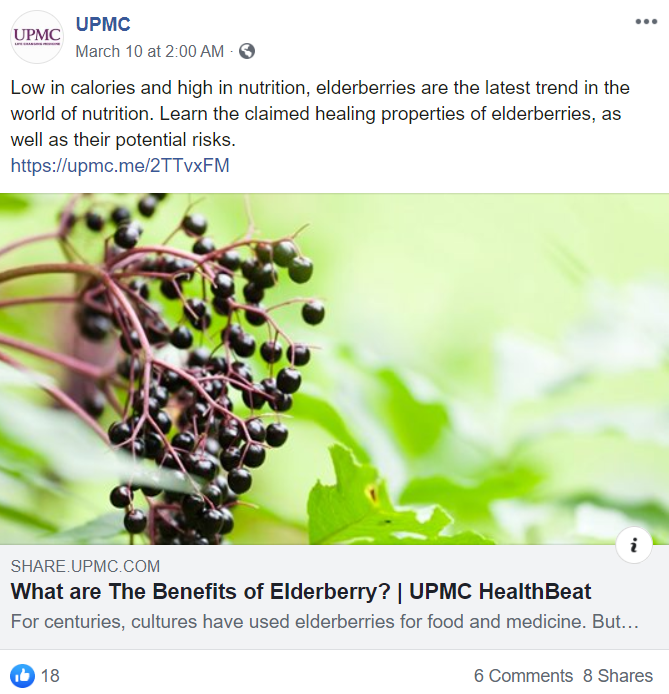
Banner health’s Facebook page has a large following, and for good reason. This page shares tons of their own content, but also links to other interesting content, shows their events schedule, and posts updates about their brand and new research findings. Here is an example of a post sharing their new blog post.
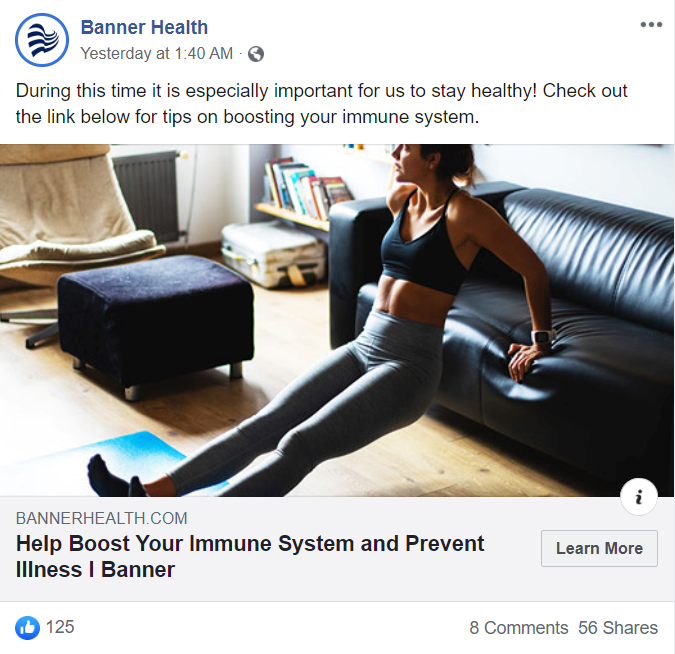
While the CDC is not a for-profit company, but a government agency, we can learn a lot about marketing in the healthcare industry from their Facebook page. Here is a post with a video about Tuberculosis, and you can see that it was quite popular with their followers.
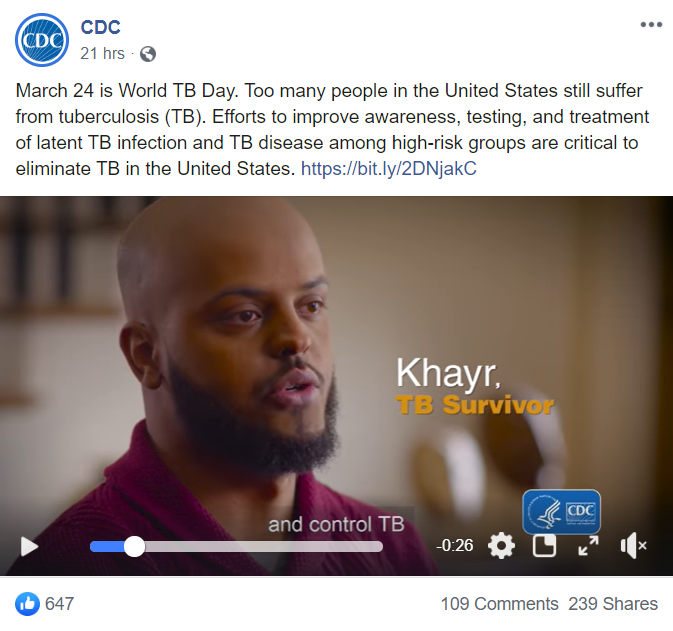
Pulling it all together
So, we talked about a lot, but there are a few key takeaways to keep in mind when you are getting started in healthcare marketing.
- Have a plan. Know to whom, when, where, and how you will roll out your marketing efforts. Without a well thought out plan, it will be difficult to get your marketing off the ground.
- Provide value. The healthcare industry is well-positioned to really help its customers during the marketing process. Offer discounts on elective procedures, share public health information and make it easy for your customers to get in touch.
- Get creative. You may need to change your existing strategy, including more channels, and get familiar with some content marketing best practices to boost your effectiveness. You’ll be glad you did.
Don’t forget that you can use SendPulse to do your marketing for totally free! Send 15,000 emails to up to 500 subscribers every month for free.







